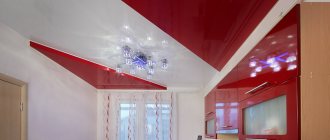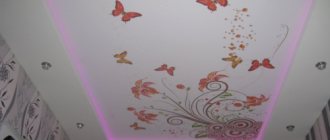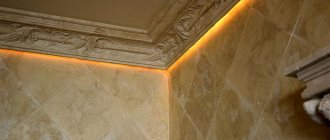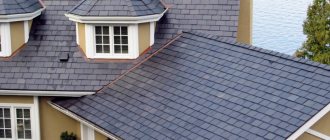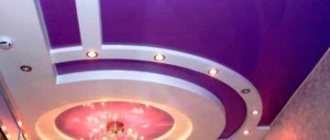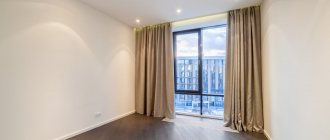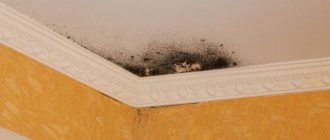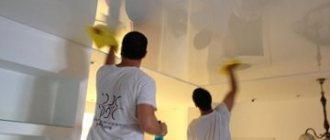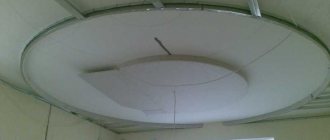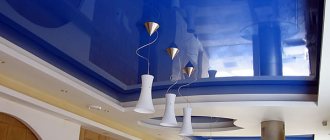Is it possible to make a suspended ceiling in a wooden house?
The use of suspended ceilings in wooden houses is becoming a popular and sought-after finishing method. By giving preference to this option, consumers can significantly save their money, since the cost of suspended ceilings is low.
In wooden houses, installation occurs in the same way as in city apartments with a concrete base. However, when performing related work, it is extremely important to pay attention to the features of installation technology. Wooden walls require special care.
Since wooden structures shrink strongly, tension fabric can be installed in them 2-3 years after construction. This will avoid possible deformations.
If a wooden house is not used for year-round living, it is not recommended to install a PVC coating (with the exception of fabric stretch ceilings in a wooden house). The material does not tolerate negative temperatures well, which will negatively affect the performance parameters of the ceiling.
The impact of low temperature on the ceiling
It is worth considering that the installation of PVC-based structures is contraindicated in unheated buildings. At temperatures below 5 degrees the material shrinks, and in severe frosts it cracks and is completely deformed. With irregular heating, PVC contracts and expands depending on the temperature of the room, which has a bad effect on its service life.
For cladding ceilings in a private house, it is better to choose fabric material. This option, although it costs more, has excellent strength. This design is practically unaffected by temperature changes and other environmental influences.
Fabric stretch ceiling Source festivalsalsacali.com
If you live in a wooden building on a permanent basis and regularly heat it, the choice of material is not particularly important.
See also: Catalog of companies that specialize in designing country houses.
Advantages and disadvantages of a stretch ceiling in a private house
Stretch ceilings as decoration for a wooden house have become commonplace due to the fact that they do an excellent job of hiding all the flaws and deformations of the ceiling covering.
Installing PVC in a wooden structure is a rather complicated operation. Its popularity among consumers is explained by a variety of positive characteristics, including:
- The tension fabric masks all ceilings, communications and pipes. If the consumer prefers this option, he will not have to spend additional money on finishing.
- It has good acoustic functions and has a positive effect on sound insulation. Extraneous sounds in a wooden building will be muffled.
- A wide range of textures and colors of stretch fabric will allow you to create an interesting design in a wooden structure.
- The canvas is not afraid of heavy loads. It can easily withstand mechanical stress of up to 100 kg per 10 sq. m of ceiling. Thanks to this, owners of wooden houses can be sure that the interior of the room will remain intact even if flooded.
- Wooden houses are characterized by gradual shrinkage. PVC does not react to this natural process; deformations do not appear on the canvas. This makes the suspended ceiling on a wooden floor a strong and reliable structure.
Along with the advantages, the use of PVC ceilings in a wooden house has some disadvantages:
- When installing suspended ceilings in a wooden house, it is necessary to prevent debris from falling onto the inner surface from the floors. Therefore, you first need to carry out rough finishing in the house.
- Decorative coating does not always suit the style of a wooden house. To choose the perfect combination in design, you will have to take the advice of professionals.
- If the walls of the house are made of solid round logs, the installation process will become noticeably more complicated. It will be difficult to install the structure in such buildings yourself.
- PVC does not like negative temperatures. This means that it can only be used as finishing in a wooden house if a constant above-zero temperature is maintained.
Important! It is not recommended to use PVC sheeting in country houses used seasonally. In winter, when a wooden structure is not heated, frost deforms the canvas and makes it fragile.
Alternatives to suspended ceilings in the country
There are better options and these are:
- Plastic ceiling
- Ceiling made of lining
- Plywood ceiling
- Regular whitewash
- Ceiling tiles
Now let’s look at each building material separately and highlight their advantages over suspended ceilings, so that you understand how best to make a ceiling.
Plastic
This type of finishing has long sunk into oblivion, due to the fact that many new, more interesting proposals have appeared (the same stretch ceilings). And, yes, for a city apartment such a ceiling is a completely frivolous option, but for a dacha it’s the sweetest thing!
It is easy to clean, easy to install, and does not require any surface preparation. But the most important thing is that he is clearly too tough for mice, because he is fat. And he handles temperature changes very well. Or rather, it does not relate to them at all, since it simply does not react to fluctuations in degrees.
So, we can confidently recommend this option to you. You don’t have to buy a completely old plastic lining. You can take panels that do not have grooves between them and in a white, matte color, the ceiling will look pretty decent.
Lining
Also a good choice. It is impossible to say that this is more expensive than suspended ceilings. The price turns out to be approximately the same. And if you also cover the surface yourself, it will be even cheaper.
A tree is a tree and the appearance of a country ceiling will be more comfortable and more expensive.
It is not at all necessary to leave it in its original form, that is, to open it with transparent varnish. The lining painted white looks very nice.
If you add some other wooden elements, for example, panels on the wall, you will get a natural “Provence”.
As for practicality, there’s nothing to say: practical, durable, beautiful, clean... Complete advantages, really.
Plywood
Quite an unusual option at first glance, but it is interesting. If you have a lot of wooden furniture or matching floors in your dacha, then a plywood ceiling will come in handy.
It does not need to be painted, it is better to leave it in its natural form. Look at the photo below to see how it looks in the interior.
Really, where is it better than a suspended ceiling? Still, whatever one may say, the latter does not “smell” of country coziness. There is something austere and urban about it.
When choosing sheets, you need to rely on their thickness. If you use too thin ones, the ceiling may not be perfectly flat. It’s better to overpay a little, but get results that will last forever.
Whitewash
The most - the simplest option, but it really is not bad. To be honest, whitewashing the ceiling in a dacha once every 3-4 years is not such a hassle. Moreover, to do this you just need to brush off the dirt from the surface, dilute the lime in a bucket and take the furniture to another room...
Is it difficult? In our opinion, no.
Another question is that the whitewashed ceiling is somehow very rustic. But, you can immediately turn this minus into a “trick”! If you buy a couple of wooden beams and place them on the ceiling as is customary to do in Alpine houses or Provençal homes, then you don’t have to worry about fashion anymore.
Simple whitewash and beams look much more fashionable than suspended ceilings.
For greater practicality, we recommend that you buy false beams, that is, plastic imitation. In this case, you won’t have to worry too much about the safety of the wood when the time comes to refresh the ceiling. The wood is saturated with the mixture, it needs to be covered with something, and if you don’t cover it, you won’t be able to wash it off. And plastic will tolerate everything, there are no shortcomings.
Look at the photo below, this is what a bleached ceiling with timber looks like.
Ceiling tiles
We mean foam tiles. It can be white, which needs painting, and it can also be colored, with a variety of patterns.
The big advantage of this option is that it also does not require surface preparation, it costs mere pennies, but it is a very practical thing to use.
All you need to do is choose a tile, buy a couple of packs of glue, such as “Dragon”, and that’s it, it’s all in the bag. If you choose laminated foam, then absolutely fine. It is very easy to wash and dirt does not really stick to it.
Believe me, this option is much better than a suspended ceiling! Simple, inexpensive, durable... Although mice love polystyrene foam, in this case they will not “covet” it, since the tiles are tightly glued to the ceiling, there are no gaps and they will not be able to get close to the material.
Types of suspended ceilings for a log house by texture
Stretch ceilings have different types of surfaces, which significantly expands its capabilities in creating a unique interior in the house. Depending on the texture of the canvas, the following types of ceilings are distinguished:
- Glossy canvas. It is characterized by a spectacular appearance and catchiness. This option has a bright shine and high reflectivity. With the right approach, you can get an airy effect that will significantly increase the volume of space. Due to the mirror effect, it is not recommended to install the canvas in rooms with heating sources and bedrooms. In the first case, due to the high temperature, the ceiling may fade, in the second, it can negatively affect the psyche.
- Matte canvas. Unlike gloss, it is not as catchy and does not have a mirror effect. In appearance it looks more like a regular painted ceiling. The use of a matte finish is recommended for calm and seasoned interiors. It is not recommended for installation in houses with low ceilings, as it visually reduces the height slightly.
- Satin fabric. This option is something between gloss and matte ceiling. It is characterized by a soft shine and unique light reflection with a scattering effect. The texture is very similar to silk fabric, which makes satin an ideal option for creating cozy interiors in the home.
What are the advantages of this ceiling covering?
The main difference between chintz stretch ceilings and glossy ones (made of PVC film) is the translucent texture of the material. The entire area of the canvas can be used to diffuse light if lamps are placed between it and the main ceiling. The soft, shadowless light resulting from this is perfect for the interiors of cozy bedrooms and living rooms.
A variety of shades and colors allows you to choose a stretch ceiling covering for any interior. Pastel, monochrome colors will harmonize perfectly with the classic and modern style of the room.
Among the advantages are the following:
- practicality and durability;
- variety of color solutions;
- aesthetically pleasing, perfectly smooth surface;
- quick installation of the structure;
- resistance to high temperatures, fire resistance;
- maintaining color and tension for many years.
Types of lighting for suspended ceilings in a country house
One of the reasons for the popularity of PVC ceilings in homes is the possibility of creating unique designs with lighting. Lighting will not only help to increase the decorative appeal of the room and emphasize the design delights, but will also visually make the room in the house more spacious and comfortable.
Lighting will also help to divide the room in the house into certain zones, which will have a positive effect on the overall interior. The most popular types of lighting are:
- contour lighting. The LED strip is attached along the edges of the PVC sheet, highlighting the corner areas. Due to the fact that the LED does not contribute to heating, the performance of the canvas will be protected;
- “floating ceiling” effect. To create it, you need to attach an LED strip or other lamps to the cornice. This will create a diffused glow, which will be visually expressed in the effect in which the structure does not touch the walls, but “hangs” in the air;
- light lines and stripes. Along the entire perimeter of the room in the house, lighting sources are installed, located in certain geometric configurations;
- spot lighting created by so-called “spot lights” located across the area of the room in a certain sequence;
- installation of a hanging chandelier, which will not only provide the required level of light, but will also become an element of the interior;
- a combination of pendant lamps and spotlights. Applicable for creating a specific light pattern in the house.
Important! As lighting sources, it is necessary to choose lamps with low power (up to 30 W) or LEDs. They will not heat the canvas, which will have a positive effect on its technical characteristics.
Fabric stretch ceilings: reviews
Reviews for both film and fabric are varied and they are both positive and negative.
One of the most sought-after and popular manufacturers of fabric ceilings is
However, according to statistical studies, experienced craftsmen and ordinary consumers try to give preference to such brands as:
- Clipso (“Clipso”, Switzerland);
- Descor (Germany);
- Cerutti (Italy);
- Emerald (Emerland, Belgium).
In the assortment of these manufacturers you can find not just canvases, but a huge selection of color, size, texture, texture and even with a bactericidal coating, which is suitable for the bathroom. Each of these suppliers is time-tested and has earned the trust of customers.
How to make suspended ceilings in a private house
Installing a stretch ceiling in a country house is not particularly difficult. It is necessary to attach special profiles to the wooden floor on which the tension fabric will be mounted.
The standard preparation procedure includes the following steps:
- Checking the integrity of the ceiling of a wooden house, eliminating possible leaks and deformations.
- Treatment of the rough ceiling with special substances that prevent the appearance of mold and microfungal organisms. It is also recommended to treat wooden structures in the house with fire retardants, which will increase the level of fire safety of the house.
- The wooden ceiling must be free of cracks and cavities. Otherwise, rodents and various insects may settle there.
- To prevent rotting of wooden structures in the house, you need to install a high-quality ventilation system. A suspended ceiling in a dacha blocks free air exchange, so ventilation is indispensable.
- Drawing up a diagram of the location of lighting fixtures, laying electrical wiring and cable ducts.
- Installation of special profiles on which the PVC structure will be mounted.
According to experts, installation in a wooden house is faster than in buildings made of concrete and brick. Given some of the characteristics of wood, installation should be approached with special attention and accuracy.
How to make a suspended ceiling in a house made of timber
If the house is made of timber, installing a suspended ceiling in a wooden house requires high qualifications, so it is almost impossible to cope with the task on your own. If the base of the house is a profiled beam, there will be no problems.
If the house consists of rounded timber, difficulties are guaranteed at the stage of attaching the profiles. If you fix a baguette in the middle of a rounded beam, there will be a joint of logs on the other side. This can complicate the installation process, since you will have to cut the profile at a difficult angle.
Therefore, it is necessary to build a substrate of boards or OSB around the entire perimeter of the room. Profiles will be attached to it.
How to make a suspended ceiling in a wooden house with beams
In this situation, difficulties will arise if the design project involves the external location of beams. When installing, you should consider the following points:
- PVC is stretched onto pre-installed base beams, after which false beams are attached on top;
- in the spaces between the beams the structure must be fixed. To do this, you should divide it into fragments with the necessary configuration.
If a suspended ceiling is made on a wooden ceiling with beams, the process involves reducing the height of the room. Therefore, it is not recommended to install it in houses with low ceilings.
How to make a suspended ceiling in a log house
Installing a ceiling in a log house is considered a rather complicated procedure. This can be explained by the fact that to facilitate the process, a special wooden base will have to be installed around the entire perimeter of the room. It will become the basis for the subsequent installation of baguettes under the suspended ceiling.
How to make a suspended ceiling above a stove in a private house
The oven is a source of heat, which negatively affects the quality and performance of PVC. To install a PVC structure in a room with a stove, you must follow the recommendations:
- A plasterboard box is installed around the chimney. It, together with the air gap, will help protect PVC from constant overheating;
- It would not be superfluous to equip a coaxial chimney with a double pipe design. Due to the increased radius for smoke exhaust, heating will decrease;
- Small wooden blocks are attached to the inside and outside of the plasterboard box. This design will become the basis for fastening profiles under a suspended ceiling.
Important! Frequent use of the stove can lead to a lot of soot and smoke. Therefore, maintenance of a suspended ceiling should be regular. It is recommended to clean it of dirt at least 1-2 times a week.
How to make a suspended ceiling on a wooden frame
A special feature of installation on a wooden frame is the need to create a preliminary structure from timber and boards. It can have any shape provided by the design project.
After creating the necessary structure, baguettes are attached to it for a suspended ceiling in a country house, after which the PVC coating is pulled onto the fastenings. If the project provides for fragmentation of the ceiling in the house, special decorative beams are installed at the junction of the tension fabric and the wooden frame.
Decorative options
The photos below will tell you the best about this.
Lighting behind the material
The translucency of the canvas turns it into a huge lampshade, hiding lighting devices behind it. In this case, the room is filled with soft diffused light, creating a special atmosphere in the room.
The large width of the material allows you to create seamless fabrics.Interior of the premises
With the help of such modifications a special atmosphere is created.
In this case you can:
- Install lamps in different parts of the ceiling, subsequently covered with fabric.
Tip: Placing lamps behind fabric makes the bedroom and living room especially cozy.
The side hidden lighting also looks beautiful.
- Painted canvases allow you to diversify the interior. You can paint them with the most suitable color, apply any image, artistic painting or photo printing to the surface, which will make the room unique and original.
Stretch chintz ceilings with artistic painting can decorate a child's room
- The ease of installation and the special properties of chintz allow you to create multi-level structures with your own hands, complementing the interiors of a living room or large dining room with this element.
Two-level ceiling with various lighting
In what rooms are they installed?
In any residential or office space, you want the ceilings to be even and smooth. This effect is achieved by installing a hanging canvas under the main base one.
Peculiarity:- It is still better not to install them in rooms that are not heated in winter;
- You should not create structures in bathrooms, toilets and kitchens. Exposure to moist heat and steam fumes can damage the appearance of the chintz covering.
Calico or satin fabrics have an external resemblance to fabric weave. The translucent airy structure of the material allows you to create special lighting in the room without affecting the strength and resistance of the structure to mechanical damage.
Tips and recommendations for caring for suspended ceilings in a cottage
A suspended ceiling needs special care, and if it is installed in a wooden house, special attention should be paid to cleanliness issues. Experts recommend using various options for cleaning ceilings:
- Dry cleaning with a vacuum cleaner. This is a quick way to get rid of small dirt and cobwebs. You need to act carefully so as not to scratch the PVC in the house.
- Dry cleaning. Allows you to remove dust from a stretch ceiling without much effort. Since the fabric is quite delicate, when dry cleaning it is recommended to use soft napkins, rags with short, not hard pile, or flannel. You need to act carefully, cleaning is done carefully, without unnecessary physical impact.
- Wet cleaning. To do this, take warm water, a small amount of detergent and a soft cloth (dish sponge). Powdered cleaning agents, abrasives and harsh chemicals are strictly prohibited.
Regarding the frequency of cleaning, everyone must decide this issue independently. If there is a stove indoors, or a PVC structure is located in the kitchen, cleaning should be frequent (at least 1-2 times a week). If you believe reviews about suspended ceilings in a private home, this will allow you to maintain perfect cleanliness and prevent the appearance of difficult-to-remove stains and dirt.
Practical use of chintz stretch ceilings
A polymer film capable of transmitting air and partially light fluxes is ideal as a material for finishing ceiling spaces in rooms where special attention is paid to maintaining the microclimate. Primarily in bedrooms, living rooms and children's rooms. The material does not emit toxic substances and does not block the normal operation of natural supply and exhaust ventilation, as is the case with glossy PVC membranes.
The presence of perforation ensures compensation and air flow into the space behind the suspended ceiling and back. As a result, chintz fabric does not flap like gloss, and does not bend under air pressure when doors or windows are opened. It seems like a small thing, but this property turns out to be very useful; for example, many owners prefer to install a chintz ceiling even in bathrooms and hallways.
